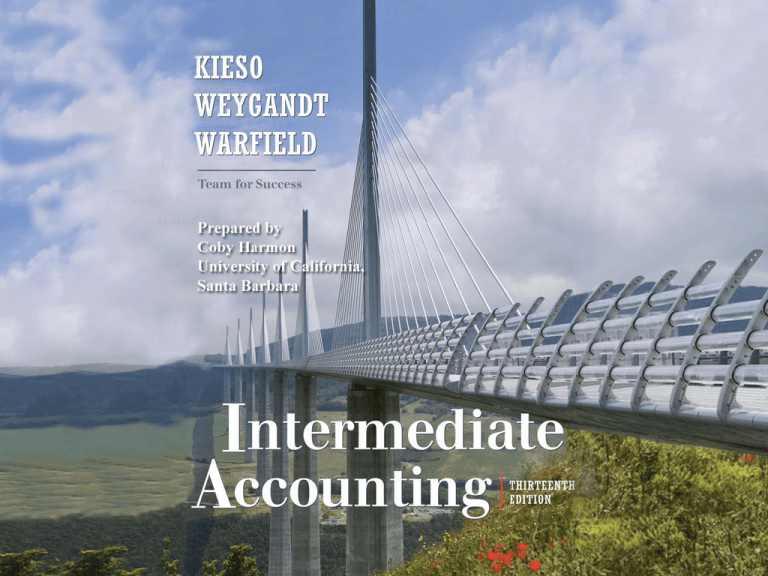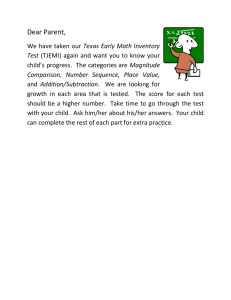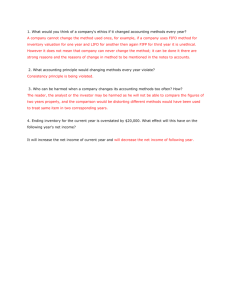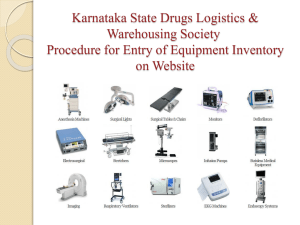
Chapter
9-1
CHAPTER
9
INVENTORIES:
ADDITIONAL VALUATION ISSUES
Intermediate Accounting
13th Edition
Kieso, Weygandt, and Warfield
Chapter
9-2
Lower-of-Cost-or-Market
LCM
A company abandons the historical cost principle when
the future utility (revenue-producing ability) of the
asset drops below its original cost.
Market = Replacement Cost
Lower of Cost or Replacement Cost
Loss should be recorded when loss occurs, not in the
period of sale.
Chapter
9-3
LO 1 Describe and apply the lower-of-cost-or-market rule.
Lower-of-Cost-or-Market
Ceiling and Floor
Why use Replacement Cost (RC) for Market?
Decline in the RC usually = decline in selling price.
RC allows a consistent rate of gross profit.
If reduction in RC fails to indicate reduction in utility,
then two additional valuation limitations are used:
Chapter
9-4
Ceiling - net realizable value and
Floor - net realizable value less a normal profit margin.
LO 1 Describe and apply the lower-of-cost-or-market rule.
Lower-of-Cost-or-Market
Illustration 9-3
What is the rationale for the
Ceiling and Floor limitations?
Ceiling = NRV
Not
>
Cost
Market
Replacement
Cost
Not
<
GAAP
LCM
Chapter
9-5
Floor =
NRV less Normal
Profit Margin
LO 1 Describe and apply the lower-of-cost-or-market rule.
Lower-of-Cost-or-Market
Rationale for Limitations
Ceiling – prevents overstatement of the value of
obsolete, damaged, or shopworn inventories.
Floor – deters understatement of inventory and
overstatement of the loss in the current period.
Chapter
9-6
LO 1 Describe and apply the lower-of-cost-or-market rule.
Lower-of-Cost-or-Market
How LCM Works (Individual Items)
Illustration 9-5
Chapter
9-7
Solution on
notes page
LO 1 Describe and apply the lower-of-cost-or-market rule.
Lower-of-Cost-or-Market
Methods of Applying LCM
Illustration 9-6
Chapter
9-8
Solution on
notes page
LO 1 Describe and apply the lower-of-cost-or-market rule.
Lower-of-Cost-or-Market
Recording LCM
(data from Illus. 9-5 and 9-6)
Ending inventory (cost)
Ending inventory (LCM)
Adjustment to LCM
Allowance
Method
Loss on inventory
Direct
Method
Cost of goods sold
Chapter
9-9
$ 415,000
350,000
$ 65,000
65,000
Allowance on inventory
Inventory
65,000
65,000
65,000
LO 1 Describe and apply the lower-of-cost-or-market rule.
Lower-of-Cost-or-Market
Balance Sheet Presentation
Allowance
Direct
Current assets:
Cash
$
$
100,000
Accounts receivable
350,000
350,000
Inventory
770,000
705,000
Less: inventory allowance
(65,000)
Prepaids
Total current assets
Chapter
9-10
100,000
20,000
20,000
1,175,000
1,175,000
LO 1 Describe and apply the lower-of-cost-or-market rule.
Lower-of-Cost-or-Market
Income Statement Presentation
Sales
Allowance
$
Cost of goods sold
300,000
Direct
$
300,000
120,000
185,000
180,000
115,000
Selling
45,000
45,000
General and administrative
20,000
20,000
Total operating expenses
65,000
65,000
65,000
-
Gross profit
Operating expenses:
Other revenue and expense:
Loss on inventory
Interest income
5,000
Total other
5,000
(60,000)
5,000
Income from operations
55,000
55,000
Income tax expense
16,500
16,500
Net income
Chapter
9-11
$
38,500
$
38,500
LO 1 Describe and apply the lower-of-cost-or-market rule.
Lower-of-Cost-or-Market
P9-1: KC Company manufactures desks. The company attempts to
obtain a 20% gross margin on selling price. At December 31, 2010,
the following finished desks appear in the company’s inventory.
Finished Desks
Inventory cost
Est. cost to manufacture
Commissions and disposal costs
Catalog selling price
A
$ 470
460
50
500
B
$ 450
430
60
540
C
$ 830
610
80
900
D
$ 960
1,000
130
1,200
Instructions: At what amount should the desks appear in the
company’s December 31, 2010, inventory, assuming that the company
has adopted a lower-of-FIFO-cost-or-market approach for valuation
of inventories on an individual-item basis?
Chapter
9-12
LO 1 Describe and apply the lower-of-cost-or-market rule.
Lower-of-Cost-or-Market
Finished Desks
Inventory cost
Est. cost to manufacture
Commissions and disposal costs
Catalog selling price
A
$ 470
460
50
500
Ceiling = 450
(500 – 50)
Not
>
Replacement
Cost = 460
Cost = 470
Market = 450
Not
<
Floor = 350
LCM = 450
Chapter
9-13
(450-(500 x 20%))
LO 1 Describe and apply the lower-of-cost-or-market rule.
Lower-of-Cost-or-Market
Finished Desks
Inventory cost
Est. cost to manufacture
Commissions and disposal costs
Catalog selling price
B
$ 450
430
60
540
Ceiling = 480
(540 – 60)
Not
>
Replacement
Cost = 430
Cost = 450
Market = 430
Not
<
Floor = 372
LCM = 430
Chapter
9-14
(480-(540 x 20%))
LO 1 Describe and apply the lower-of-cost-or-market rule.
Lower-of-Cost-or-Market
Finished Desks
Inventory cost
Est. cost to manufacture
Commissions and disposal costs
Catalog selling price
C
$ 830
610
80
900
Ceiling = 820
(900 – 80)
Not
>
Replacement
Cost = 610
Cost = 830
Market = 640
Not
<
Floor = 640
LCM = 640
Chapter
9-15
(820-(900 x 20%))
LO 1 Describe and apply the lower-of-cost-or-market rule.
Lower-of-Cost-or-Market
Finished Desks
Inventory cost
Est. cost to manufacture
Commissions and disposal costs
Catalog selling price
D
$ 960
1,000
130
1,200
Ceiling = 1,070
(1,200 – 130)
Not
>
Replacement
Cost = 1,000
Cost = 960
Market = 1,000
Not
<
Floor = 830
LCM = 960
Chapter
9-16
(1,070-(1,200 x 20%))
LO 1 Describe and apply the lower-of-cost-or-market rule.
Lower-of-Cost-or-Market
Evaluation of LCM Rule
Some Deficiencies:
Expense recorded when loss in utility occurs. Profit on sale
recognized at the point of sale.
Inventory valued at cost in one year and at market in the
next year.
Net income in year of loss is lower. Net income in subsequent
period may be higher than normal if expected reductions in
sales price do not materialize.
LCM uses a “normal profit” in determining inventory values,
which is a subjective measure.
Chapter
9-17
LO 1 Describe and apply the lower-of-cost-or-market rule.
Valuation Bases
Net Realizable Value
Permitted by GAAP under the following conditions:
(1) a controlled market with a quoted price applicable to
all quantities, and
(2) no significant costs of disposal (rare metals and
agricultural products)
or
(3) too difficult to obtain cost figures (meatpacking)
Chapter
9-18
LO 2 Explain when companies value inventories at net realizable value.
Valuation Bases
Relative Sales Value
Used when buying varying units in a single lump-sum purchase.
E9-7: Larsen Realty Corporation purchased a tract of unimproved land
for $55,000. This land was improved and subdivided into building lots at
an additional cost of $30,000. These building lots were all of the same
size but owing to differences in location were offered for sale at
different prices as follows. Operating expenses allocated to this project
total $18,200.
Chapter
9-19
Group
No. of
Lots
1
9
2
3
Price
per Lot
$
Lots Unsold
at Year-End
3,000
5
15
4,000
7
19
2,000
2
Instructions: Calculate
the net income realized
on this operation to
date.
LO 3 Explain when companies use the relative
sales value method to value inventories.
Valuation Bases
E9-7 (Relative Sales Value Method - Solution)
Group
No. of x Price
Lots
per Lot
1
9
2
15
3
19
Selling
Price
=
$ 3,000
$
Relative
Sales Price
x
=
Cost
Allocated
Cost
Per Lot
27,000
$27,000/125,000
$ 85,000
$ 18,360
$ 2,040
4,000
60,000
60,000/125,000
85,000
40,800
2,720
2,000
38,000
38,000/125,000
85,000
25,840
1,360
$ 125,000
Group
Total
Cost
Lots
Price
x
Sold
per Lot
=
$ 85,000
Total
Sales
Cost
Per Lot
Total Cost
of Goods
Calculation of Net Income
Sales
$ 78,000
$
Cost of good sold
53,040
1
4
$ 3,000
$ 12,000
$ 2,040
2
8
4,000
32,000
2,720
21,760
Gross profit
24,960
3
17
2,000
34,000
1,360
23,120
Expenses
18,200
$ 78,000
Chapter
9-20
8,160
$ 53,040
Net income
$
6,760
LO 3 Explain when companies use the relative
sales value method to value inventories.
Valuation Bases
Purchase Commitments
Generally seller retains title to the merchandise.
Buyer recognizes no asset or liability.
If material, the buyer should disclose contract details in
footnote.
If the contract price is greater than the market price,
and the buyer expects that losses will occur when the
purchase is effected, the buyer should recognize losses
in the period during which such declines in market prices
take place.
Chapter
9-21
LO 4 Discuss accounting issues related to purchase commitments.
Valuation Bases
Illustration: St. Regis Paper Co. signed timber-cutting
contracts to be executed in 2012 at a price of
$10,000,000. Assume further that the market price of
the timber cutting rights on December 31, 2011, dropped
to $7,000,000. St. Regis would make the following entry
on December 31, 2011.
Unrealized Holding Gain or Loss—Income
3,000,000
Estimated Liability on Purchase Commitments
Chapter
9-22
3,000,000
LO 4 Discuss accounting issues related to purchase commitments.
Valuation Bases
Illustration: When St. Regis cuts the timber at a cost of
$10 million, it would make the following entry.
Purchases (Inventory)
7,000,000
Estimated Liability
3,000,000
Cash
10,000,000
If Congress permitted St. Regis to reduce its contract
price and therefore its commitment by $1,000,000.
Estimated Liability
1,000,000
Unrealized Holding Gain or Loss—Income
Chapter
9-23
1,000,000
LO 4 Discuss accounting issues related to purchase commitments.
Retail Inventory Method
A method used by retailers, to value inventory without
a physical count, by converting retail prices to cost.
Requires retailers to keep:
(1) the total cost and retail value of goods purchased,
(2) the total cost and retail value of the goods available
for sale, and
(3) the sales for the period.
Chapter
9-24
LO 6 Determine ending inventory by applying the retail inventory method.
Retail Inventory Method
P9-8: Fuque Inc. uses the retail inventory method to
estimate ending inventory for its monthly financial
statements. The following data pertain to a single
department for the month of October 2011.
Instructions:
Beg. inventory, Oct. 1
Purchases
Freight in
Purchase returns
Additional markups
Markup cancellations
Markdowns (net)
Normal spoilage
Sales
Chapter
9-25
COST
$
52,000
272,000
16,600
5,600
RETAIL
$ 78,000
423,000
8,000
9,000
2,000
3,600
10,000
390,000
Prepare a schedule
computing estimate
retail inventory
using the following
methods:
(1) Cost
(2) LCM
(3) LIFO (appendix)
LO 6 Determine ending inventory by applying the retail inventory method.
Retail Inventory - Cost Method
P9-8 Solution - Cost Method
Beg. inventory
Purchases
Freight in
Purchase returns
Markdowns, net
Markups, net
Current year additions
Goods available for sale
Normal spoilage
Sales
Ending inventory at retail
Ending inventory at Cost:
$ 96,400 x 67.49% =
Chapter
9-26
COST
$
52,000
272,000
16,600
(5,600)
RETAIL
$ 78,000
423,000
(8,000)
(3,600)
7,000
283,000
418,400
335,000 /
496,400 =
(10,000)
(390,000)
$ 96,400
$
Cost to
Retail %
67.49%
65,056
LO 6 Determine ending inventory by applying the retail inventory method.
Retail Inventory - LCM Method
P9-8 Solution - LCM (CONVENTIONAL) Method:
Beg. inventory
Purchases
Freight in
Purchase returns
Markups, net
Current year additions
Goods available for sale
Markdowns, net
Normal spoilage
Sales
Ending inventory at retail
Ending inventory at Cost:
$
96,400 x 67.00% =
Chapter
9-27
COST
$
52,000
272,000
16,600
(5,600)
283,000
335,000 /
$
RETAIL
$ 78,000
423,000
(8,000)
7,000
422,000
500,000 =
(3,600)
(10,000)
(390,000)
$ 96,400
Cost to
Retail %
67.00%
64,588
LO 6 Determine ending inventory by applying the retail inventory method.
Retail Inventory - LIFO Method
P9-8 Solution - LIFO Method:
Beg. inventory
Purchases
Freight in
Purchase returns
Markdowns, net
Markups, net
Current year additions
Goods available for sale
Normal spoilage
Sales
Ending inventory at retail
Ending inventory at Cost:
PY $
78,000 x
66.67% =
CY
18,400 x
67.64% =
$
96,400
Chapter
9-28
Cost to
Retail %
=
66.67%
COST
RETAIL
$
52,000 / $ 78,000
272,000
423,000
16,600
(5,600)
(8,000)
(3,600)
7,000
/
283,000
418,400 =
335,000
496,400
(10,000)
(390,000)
$ 96,400
$
$
52,000
12,446
64,446
67.64%
Appendix 9A
LO 8 Determine ending inventory by applying the LIFO retail inventory methods.
Retail Inventory Method
Evaluation:
Widely used for the following reasons:
(1) to permit the computation of net income without a
physical count of inventory,
(2) as a control measure in determining inventory
shortages,
(3) in regulating quantities of merchandise on hand, and
(4) for insurance information.
Some companies refine the retail method by computing inventory separately
by departments or class of merchandise with similar gross profits.
Chapter
9-29
LO 6 Determine ending inventory by applying the retail inventory method.
Presentation and Analysis
Presentation:
Accounting standards require disclosure of:
(1) composition of the inventory,
(2) financing arrangements, and
(3) costing methods employed.
Analysis:
Common ratios used in the management and evaluation of
inventory levels are inventory turnover and average days
to sell the inventory.
Chapter
9-30
LO 7 Explain how to report and analyze inventory.
Presentation and Analysis
Inventory Turnover Ratio
Measures the number of times on average a company
sells the inventory during the period.
Illustration 9-26
Chapter
9-31
LO 7 Explain how to report and analyze inventory.
Presentation and Analysis
Average Days to Sell Inventory
Measure represents the average number of days’
sales for which a company has inventory on hand.
Illustration 9-26
Average Days to Sell
365 days / 7.5 times = every 48.7 days
Chapter
9-32
LO 7 Explain how to report and analyze inventory.
U.S. GAAP permits the use of LIFO for inventory valuation. iGAAP
prohibits its use.
In the lower-of-cost-or-market test for inventory valuation, iGAAP
defines market as net realizable value. U.S. GAAP defines market
as replacement cost subject to the constraints.
In U.S. GAAP, inventory written down under the lower-of-cost-ormarket valuation may not be written back up to its original cost in a
subsequent period. Under iGAAP, the write-down may be reversed
in a subsequent period.
Chapter
9-33
Copyright
Copyright © 2009 John Wiley & Sons, Inc. All rights reserved.
Reproduction or translation of this work beyond that permitted
in Section 117 of the 1976 United States Copyright Act without
the express written permission of the copyright owner is
unlawful. Request for further information should be addressed
to the Permissions Department, John Wiley & Sons, Inc. The
purchaser may make back-up copies for his/her own use only
and not for distribution or resale. The Publisher assumes no
responsibility for errors, omissions, or damages, caused by the
use of these programs or from the use of the information
contained herein.
Chapter
9-34





